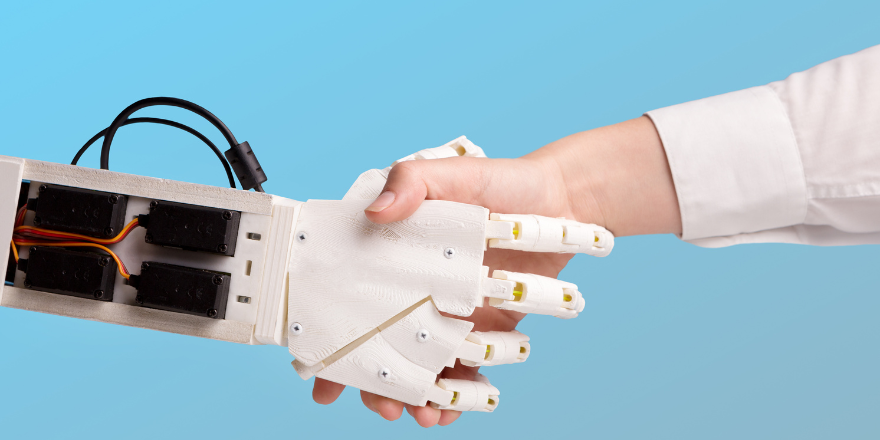Topics: Resource Optimization, PlanetTogether Software, Integrating PlanetTogether, Real-Time Data Exchange, Adaptive Scheduling, Intelligent Predictive Analytics, Collaborative Platforms

The integration of advanced technologies has paved the way for unprecedented levels of efficiency, precision, and innovation. One of the most transformative developments is the emergence of human-robot collaboration (HRC), particularly in medical manufacturing facilities. This synergy between humans and robots holds immense potential to revolutionize the industry, but it also comes with its fair share of scheduling challenges.
In this blog, we will explore the dynamics of HRC in medical manufacturing and look into the integration between PlanetTogether and leading ERP, SCM, and MES systems like SAP, Oracle, Microsoft, Kinaxis, and Aveva to overcome these scheduling hurdles.
Understanding Human-Robot Collaboration in Medical Manufacturing
Human-robot collaboration is a concept that blends the capabilities of both human workers and robotic systems to accomplish manufacturing tasks. In the medical sector, this collaboration becomes crucial due to the intricate nature of producing life-saving equipment and devices. Robots can handle repetitive, high-precision tasks, while humans contribute their adaptability, creativity, and problem-solving skills. This collaboration streamlines production, reduces errors, and enhances overall product quality.
However, orchestrating this harmonious partnership comes with its own set of challenges, particularly when it comes to scheduling and coordination.
Scheduling Challenges in Human-Robot Collaboration
Complex Task Allocation: Assigning tasks to the most suitable entities (human or robot) is a nuanced process. Some tasks demand human intuition and dexterity, while others require robotic speed and accuracy. Balancing this allocation optimally can be a significant challenge.
Dynamic Task Prioritization: In medical manufacturing, priorities can shift rapidly based on factors such as demand fluctuations, regulatory changes, and equipment maintenance. Adapting to these changes while ensuring seamless human-robot cooperation is no small feat.
Optimal Resource Utilization: Efficient utilization of resources, including both human and robotic, is crucial to prevent bottlenecks and ensure a smooth production flow. This requires real-time adjustments and precise scheduling.
Safety Considerations: The safety of human workers collaborating with robots is paramount. Scheduling must account for safety measures, training periods, and maintenance routines to minimize potential hazards.
Communication and Coordination: Effective communication between humans and robots is essential for successful collaboration. Ensuring that tasks are executed in the correct order and that information flows seamlessly is a constant challenge.
Data Integration: Gathering and analyzing data from various sources, including ERP, SCM, and MES systems, is essential for informed decision-making. Integrating this data to enhance scheduling accuracy presents a unique challenge.
Leveraging Technology for Seamless Integration
The integration of advanced scheduling solutions like PlanetTogether with ERP, SCM, and MES systems offers a comprehensive approach to overcoming the scheduling challenges of HRC in medical manufacturing.
Here's how:
Real-time Data Exchange: Integration enables the continuous flow of real-time data between different systems. This ensures that the most up-to-date information about demand, inventory, and production status is available for scheduling decisions.
Predictive Analytics: Advanced analytics tools can process historical and real-time data to predict demand fluctuations and production bottlenecks. This enables proactive scheduling adjustments to meet changing requirements.
Resource Optimization: Integration allows for the optimization of resources, both human and robotic. Algorithms can intelligently allocate tasks based on factors such as skill sets, availability, and machine capabilities.
Collaborative Platforms: Integrated systems provide a centralized platform for communication and coordination between humans and robots. This minimizes errors and ensures tasks are executed in the correct sequence.
Adaptive Scheduling: With integration, scheduling becomes more adaptable to changes in priorities, equipment availability, and unforeseen disruptions. This flexibility is vital for HRC in a dynamic medical manufacturing environment.
The synergy between human workers and robotic systems in medical manufacturing holds immense promise for the industry's future. However, the scheduling challenges that come with human-robot collaboration require innovative solutions. Integrating advanced scheduling tools like PlanetTogether with leading ERP, SCM, and MES systems empowers medical manufacturing facilities to tackle these challenges head-on.
As we navigate the complexities of the manufacturing landscape, the integration between technology, data, and human expertise will continue to play a pivotal role. By embracing integration and leveraging the strengths of both humans and robots, we can drive the medical manufacturing sector towards unparalleled levels of efficiency, precision, and success.
Topics: Resource Optimization, PlanetTogether Software, Integrating PlanetTogether, Real-Time Data Exchange, Adaptive Scheduling, Intelligent Predictive Analytics, Collaborative Platforms
0 Comments
No video selected
Select a video type in the sidebar.







LEAVE A COMMENT